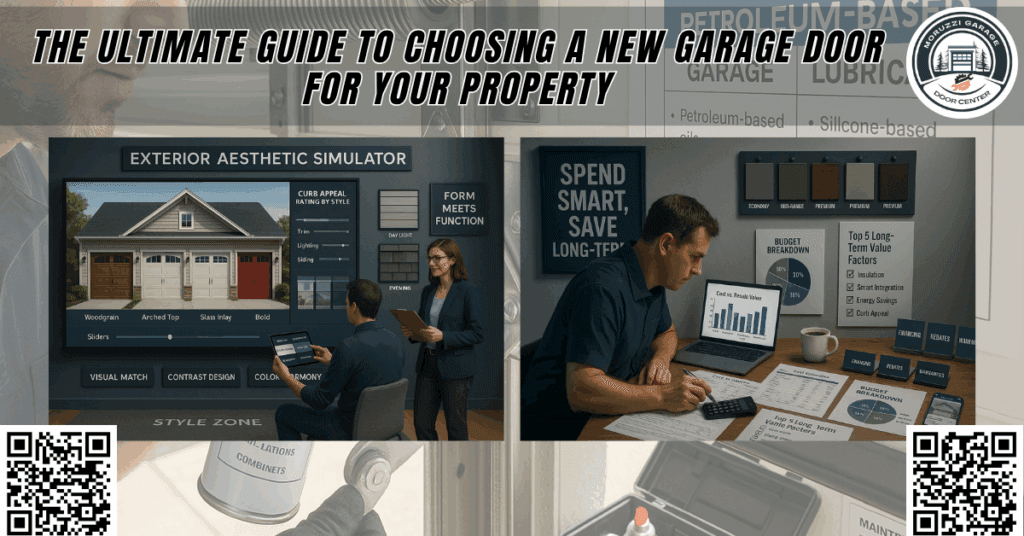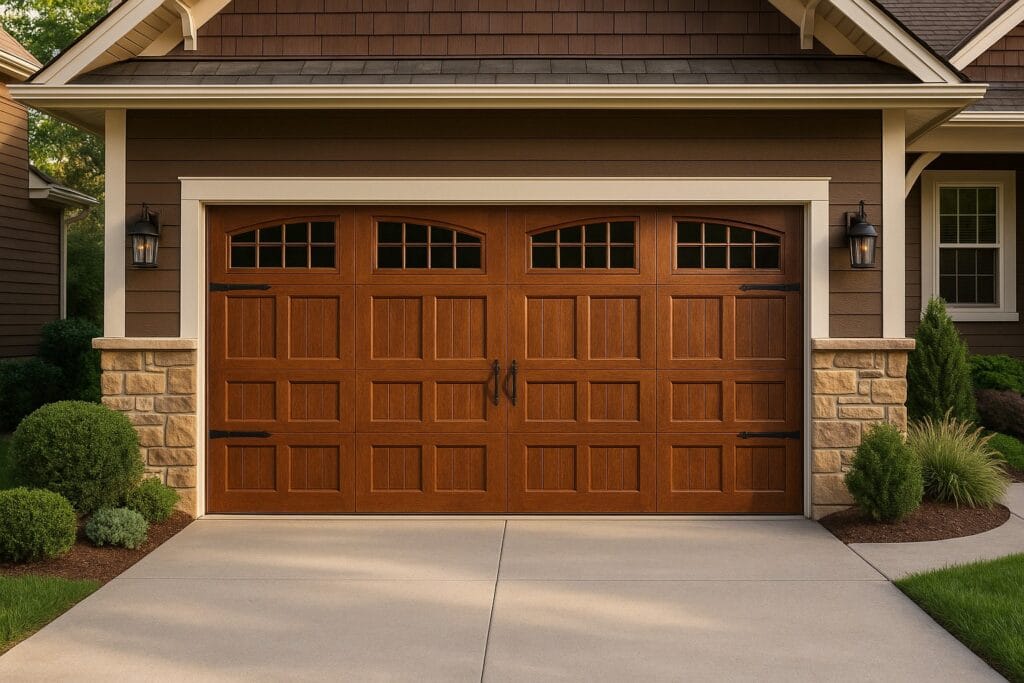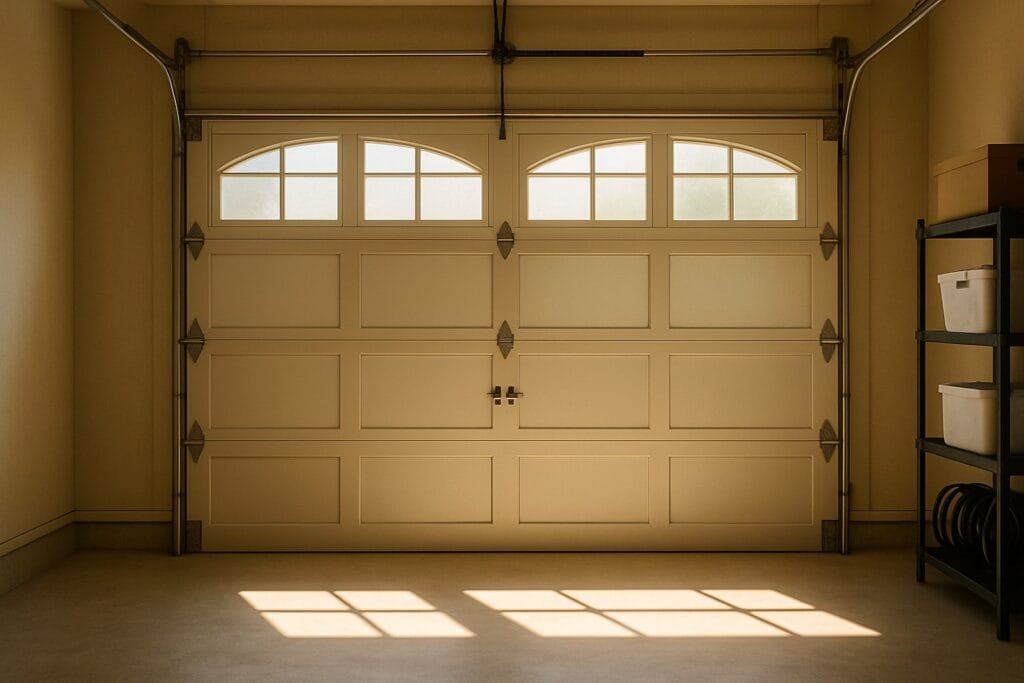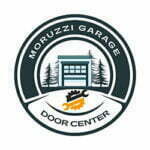The Ultimate Guide to Choosing a New Garage Door for Your Property

When the Simmons family in Philadelphia noticed their garage door was sticking and making strange noises, they assumed it just needed a little oil. But one morning, the door completely jammed, trapping their car just as they were about to leave for a wedding. They called Moruzzi Garage Door Center, and our team of professionals quickly discovered worn-out garage door springs, a failing garage door opener, and a heavily warped wooden panel that had begun to delaminate. We guided them through the process of selecting a new garage door that fit their home’s style, budget, and functional needs. Today, the Simmons enjoys a custom garage door installation that improves security, insulation, and curb appeal.
They’re not alone. According to Remodeling Magazine’s 2024 Cost vs. Value report, a garage door replacement is one of the most cost-effective home improvement projects, delivering up to 102.7% return on investment. That’s higher than a kitchen remodel or window replacement. Why? Because a new garage door dramatically impacts curb appeal, energy efficiency, and home security, all while offering homeowners modern features like smart garage door openers, improved insulation with higher R-values, and enhanced durability from new materials like steel, composite, and fiberglass. It’s also a prominent part of your home’s exterior and one of the first things people see, making it a key contributor to the home’s visual appeal and market value.
Whether you’re replacing a damaged unit, upgrading for efficiency, or designing a custom garage door for a new build, this comprehensive guide will walk you through everything you need to consider. From garage door styles and materials to openers, safety features, and professional installation tips, you’ll find it all here. Choosing a new garage door is a major decision that involves several factors, and we’re here to help you make the best one. We aim to simplify the process, inform your decisions, and ensure your investment stands the test of time.
1. Assessing Your Needs: Why Do You Need a New Garage Door?
The first step in choosing a new garage door is identifying why you need one. Has your current garage door stopped working? Is it showing signs of wear like rust, rot, or peeling paint? Or are you remodeling your home and want to upgrade the garage door design to match the new aesthetic? Understanding your “why” helps narrow down your options and ensure the new installation meets your expectations.
Common reasons include broken garage door springs, malfunctioning garage door openers, severe weather damage, or simple old age (most garage doors last 15-30 years). For others, the goal is improved energy efficiency, noise reduction, or better security. Perhaps you’re looking for a more modern look to increase your curb appeal, or your existing door lacks smart features. Whatever your situation, a new door is an opportunity to solve existing problems while enhancing your home’s appearance and functionality. Always take into account how your garage is used, as a workspace, a storage area, or even a home gym, when determining your needs.
2. Exploring Garage Door Styles: Find the Right Look
Garage doors come in a wide range of styles, each offering unique benefits and visual appeal. Popular options include traditional raised-panel garage doors, contemporary aluminum and glass models, and classic carriage house garage doors that open overhead but mimic old swing-out barn doors. Craftsman garage doors are a favorite among homeowners who appreciate detailed woodwork and vintage charm. Modern minimalists may prefer sleek flush-panel doors with metallic or matte finishes.
Choosing the right style is about more than aesthetics. You should also consider your home’s architecture, the available space, and your maintenance preferences. Sectional garage doors are the most common due to their space-saving vertical lift, while swing-out or slide-to-side designs require more clearance. French doors are less common but ideal for certain specialty applications, such as converting a garage into a home office. Your style should reflect both personal taste and functional requirements, a harmonious blend of form and purpose.

A professional consultation can help you visualize how different garage door styles will complement your home. Tools like design software or augmented reality apps can offer a preview before committing to a final look. Don’t forget to consider how your garage door coordinates with the rest of your exterior design, including trim, siding, roofing, and driveway layout.
3. Choosing the Best Materials: Steel, Wood, Vinyl, and More
Garage door materials affect not just appearance but also cost, durability, insulation, and maintenance needs. Steel doors are the most popular due to their strength, affordability, and low upkeep. They come in various gauges (thickness levels) and can be customized with overlays, textures, and color finishes. Insulated steel garage doors offer excellent energy efficiency, especially in cold weather, and resist denting and rust with the right coating.
Wood garage doors, including custom or craftsman styles, offer unmatched natural beauty and can be tailored to any design. However, they require regular maintenance and may delaminate or warp in humid climates. They are best suited for homeowners who value aesthetics over convenience and are willing to perform seasonal maintenance. Composite doors mimic wood but are lighter and more weather-resistant. Vinyl and fiberglass doors are low-maintenance and resistant to salt, moisture, and dents, making them ideal for coastal areas or homes exposed to extreme weather.
Aluminum doors are lightweight and often used in contemporary glass-paneled designs, while fiberglass doors can mimic wood without the upkeep. Each material offers trade-offs in pricing, insulation, and longevity. Consider climate, exposure to sunlight, budget, and whether you’re planning to sell your home soon. Consulting with professionals like Moruzzi Garage Door Center can help match material to your climate, budget, and design preferences.
4. Insulation and Energy Efficiency: Why R-Value Matters
Insulation plays a major role in the performance of your garage door, especially if your garage is attached to your house or used as a workspace. The R-value measures a door’s thermal resistance; the higher the R-value, the better the insulation. Steel doors with polyurethane or polystyrene core insulation can reach R-values of 13 to 17, offering significant energy savings throughout the year.
Proper insulation keeps your garage warmer in winter and cooler in summer, reducing energy costs and improving comfort. This is crucial for homeowners who use their garage for hobbies, storage, or as a laundry area. Insulated doors also reduce noise, which is helpful in busy neighborhoods or near main roads. It also helps maintain temperature-sensitive items such as paints, tools, and electronics stored in your garage.
Beyond temperature control, insulation adds rigidity to the door, improving durability and reducing vibration when opening or closing. Even if you don’t spend much time in your garage, an insulated garage door can increase overall home efficiency and reduce wear on your HVAC system. Investing in energy-efficient garage doors is a smart long-term decision.
5. Garage Door Openers: Features, Types, and Technology
Modern garage door openers are more than just motors; they’re smart, safe, and convenient. You can choose from several types, including chain-drive, belt-drive, screw-drive, and wall-mounted openers. Belt-drive models are quieter and ideal for attached garages, while chain drives are durable and more budget-friendly. Wall-mounted (jackshaft) openers save ceiling space and are ideal for garages with high or sloped ceilings.
Smart garage door openers allow you to open and close your garage via smartphone apps, voice control, or even automation routines. Many come with battery backup, built-in LED lighting, and safety features like rolling code technology and auto-reverse mechanisms. These features provide not only convenience but also enhanced security and peace of mind.
For added convenience, consider options with Wi-Fi connectivity, integration with smart home systems, and security cameras. You can receive alerts if your door is left open and even monitor activity via live video feeds. Some garage door openers now support Amazon Key and similar services, allowing for secure in-garage deliveries.
6. Sizing and Space Considerations
Garage doors are available in standard sizes, but custom sizes are also common. A single-car garage typically uses a 9’x7′ door, while a double-car garage may use a 16’x7′ model. However, modern homes often have different dimensions requiring a precise fit. For specialty garages, such as RV storage or workshops, oversized or custom-built doors may be necessary.
Also, consider the headroom and backroom space needed for installation. Some garages may require low-clearance or high-lift track systems. Sectional garage doors are space-efficient, while overhead doors need room to rise and store above the car. Ceiling-mounted storage or lighting fixtures should be factored into the installation layout.
Professional measurements help avoid misalignment, unnecessary gaps, or damage to surrounding structures. Don’t forget to consider driveway slope, nearby landscaping, and how much vertical lift is required to ensure the new garage door functions smoothly in all conditions.
7. Safety Features: Protecting Your Family and Property
Garage doors are heavy moving objects, and safety should always be a priority. Modern doors come equipped with built-in safety features such as auto-reverse sensors that stop the door if something is in the way. Pinch-resistant panels and tamper-resistant brackets reduce the risk of injury. These features are particularly important for households with children and pets.
Garage door openers should include rolling code technology to prevent hacking. Battery backups ensure the door operates even during power outages. Safety beams and motion detection lights further protect against accidents and intruders. Advanced models even send notifications if the door is left open for too long.
Regular maintenance and inspections help keep springs, cables, and tracks in top shape. Replacing worn garage door springs or frayed cables is essential to prevent accidents. Having your garage door professionally inspected annually can help catch issues before they become safety hazards.
8. Additional Features and Customization Options
There’s more to a garage door than panels and paint. Additional features like windows, decorative hardware, and smart technology add style and function. Frosted or insulated glass panels improve light without compromising privacy. Adding windows can also enhance curb appeal and natural lighting in the garage.

You can also select from a wide range of colors, finishes (like woodgrain or matte black), and panel patterns. For historic or luxury homes, a custom garage door can include unique carvings, arches, or iron details. Specialty designs can incorporate barn-style overlays, carriage house handles, and antique hinges.
Smart features like app controls, automated lighting, and voice commands are becoming more common. These enhancements offer convenience and increase property value. Even things like quiet operation, soft start/stop motors, and smart climate control can make a significant difference in user experience.
9. Understanding Garage Door Costs: Materials, Labor, and More
The cost of a new garage door depends on several factors: materials, size, insulation, customization, and installation complexity. On average, homeowners spend between $800 to $4,000 or more, depending on their choices. Wooden doors and custom garage door designs generally fall on the higher end, while steel and vinyl doors tend to be more affordable.
Labor costs also play a role. A basic installation may cost $200 to $500, but complex or custom jobs can go higher. Don’t forget to budget for the garage door opener, which may add another $150 to $500. Adding smart features, higher insulation, or premium finishes will also increase the final price.
At Moruzzi Garage Door Center, we provide upfront pricing and free estimates to help you plan accurately. Our goal is to ensure your investment delivers long-term value. We believe in transparent communication and quality service with no hidden fees.
10. DIY vs. Professional Installation: What to Consider
Installing a garage door may seem like a weekend project, but it involves precise measurements, heavy lifting, and technical know-how. Mistakes can lead to safety hazards or shorten the lifespan of your new garage door. That’s why we always recommend professional installation.
A trained technician ensures proper alignment, tensioning of springs, and configuration of garage door openers. They also conduct safety inspections and test all components. Professionals understand how to navigate structural challenges and meet local building codes.
In most cases, the added labor cost is worth the peace of mind. You gain warranty protection, expert workmanship, and a faster installation timeline. Moruzzi Garage Door Center offers certified installation services and backs every project with a satisfaction guarantee.
11. Maintenance and Repair: Keeping Your Door in Top Shape
Even the best garage doors require regular maintenance to stay in good condition. Annual inspections of springs, rollers, tracks, and garage door openers can prevent costly repairs. Look for signs of wear like rust, sagging panels, slow response, or unusual noises.
Lubricate moving parts, replace batteries in your opener, and clear debris from the tracks. Avoid DIY repairs on high-tension parts like garage door springs, these should always be handled by professionals. Staying proactive can extend the life of your garage door by several years and reduce emergency service calls.
Moruzzi Garage Door Center offers affordable maintenance and repair services to keep your door operating smoothly year after year. We recommend scheduling a tune-up every 12 months for best results. Our technicians will inspect all mechanical parts, safety sensors, and opener functions to ensure everything runs efficiently.
Final Thoughts: Making the Right Choice for Your Home
Choosing a new garage door is a significant decision that impacts your home’s function, safety, and appearance. From selecting the right materials and design to understanding installation complexity and long-term maintenance, there are many factors to weigh.
Take the time to consider your lifestyle, climate, budget, and aesthetic goals. Whether you’re looking for a durable steel option with energy-efficient insulation or a handcrafted wooden design that adds classic charm, there’s a perfect solution for every homeowner.
A professionally installed, well-maintained garage door can last for decades while enhancing your property’s curb appeal and resale value. Don’t underestimate how much of a difference the right door can make, both visually and practically. Educate yourself, consult the experts, and invest in a solution you’ll appreciate every time you pull into your driveway.
How Can Moruzzi Garage Door Center Help You?
At Moruzzi Garage Door Center, we understand that your garage door isn’t just a door; it’s an essential part of your home. That’s why we offer personalized service and expert installation tailored to your needs. Whether you’re replacing a damaged garage door, upgrading for better insulation, or looking for a custom design, our experienced team is here to help.
We proudly serve homeowners and businesses across Philadelphia, PA, and the surrounding areas. Our services include garage door installation, repair, replacement, spring repair, opener upgrades, and regular maintenance. With years of experience and a commitment to customer satisfaction, we guarantee quality work at competitive prices.
Ready to get started? Visit us at 1300 Market St, Philadelphia, PA 19107, or call us today at (267) 732-0907 to schedule your free estimate. Let Moruzzi Garage Door Center be your trusted partner in finding the perfect new garage door for your property.
Frequently Asked Questions (FAQs)
Q1: How long does a garage door installation usually take from start to finish?
A: Most installations take 4–6 hours, but custom doors or opener upgrades may extend the timeline to a full day.
Q2: Do garage doors require permits or HOA approval in Philadelphia?
A: In some neighborhoods, yes—especially if you’re installing a custom or carriage house style; always check local regulations or consult with your installer.
Q3: Can I reuse my old garage door opener with a new door?
A: Sometimes, but it’s recommended to upgrade your opener for better compatibility, safety features, and performance.
Q4: What maintenance should I schedule annually for my garage door?
A: Annual maintenance should include spring tension checks, track alignment, opener calibration, and lubrication of all moving parts.
